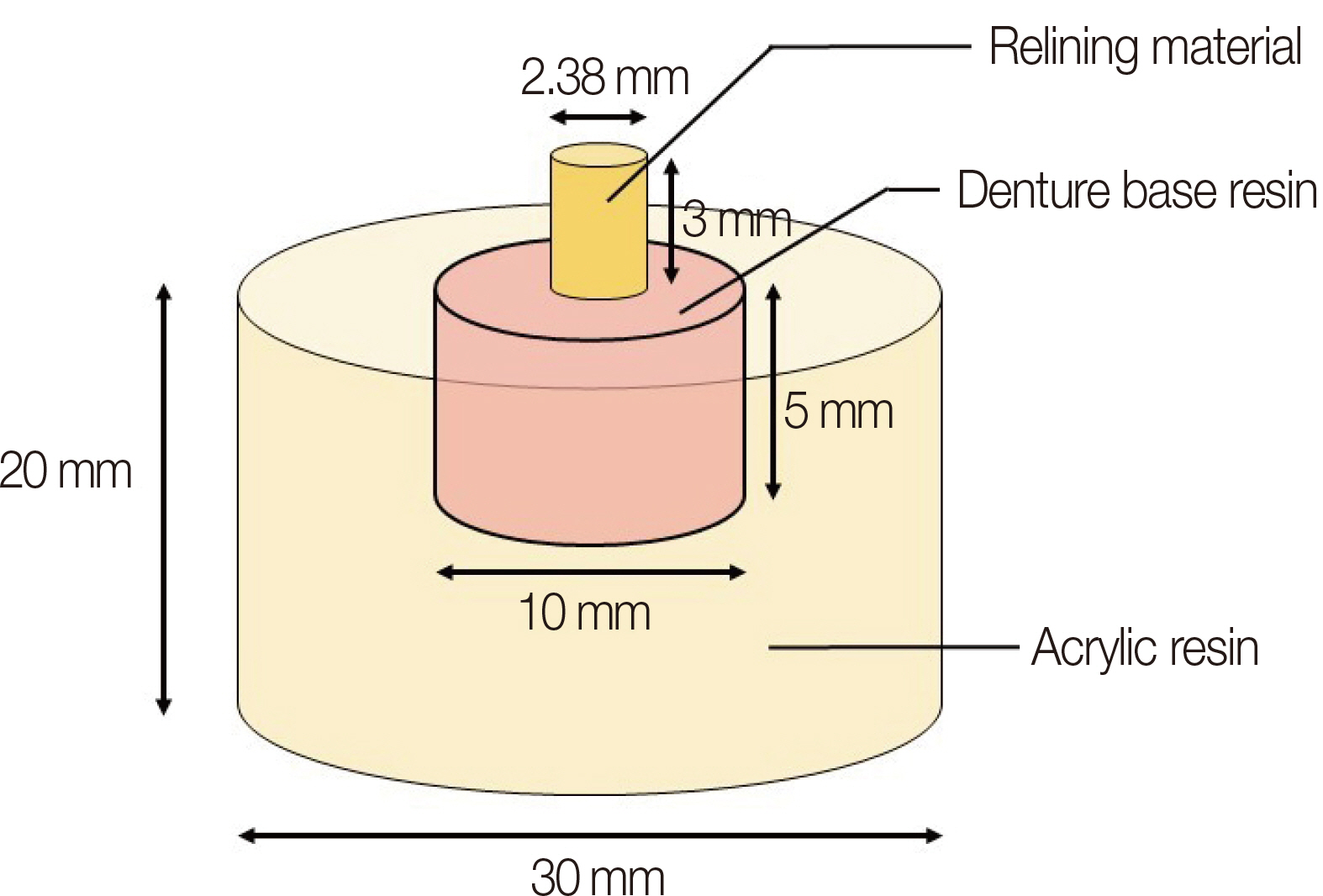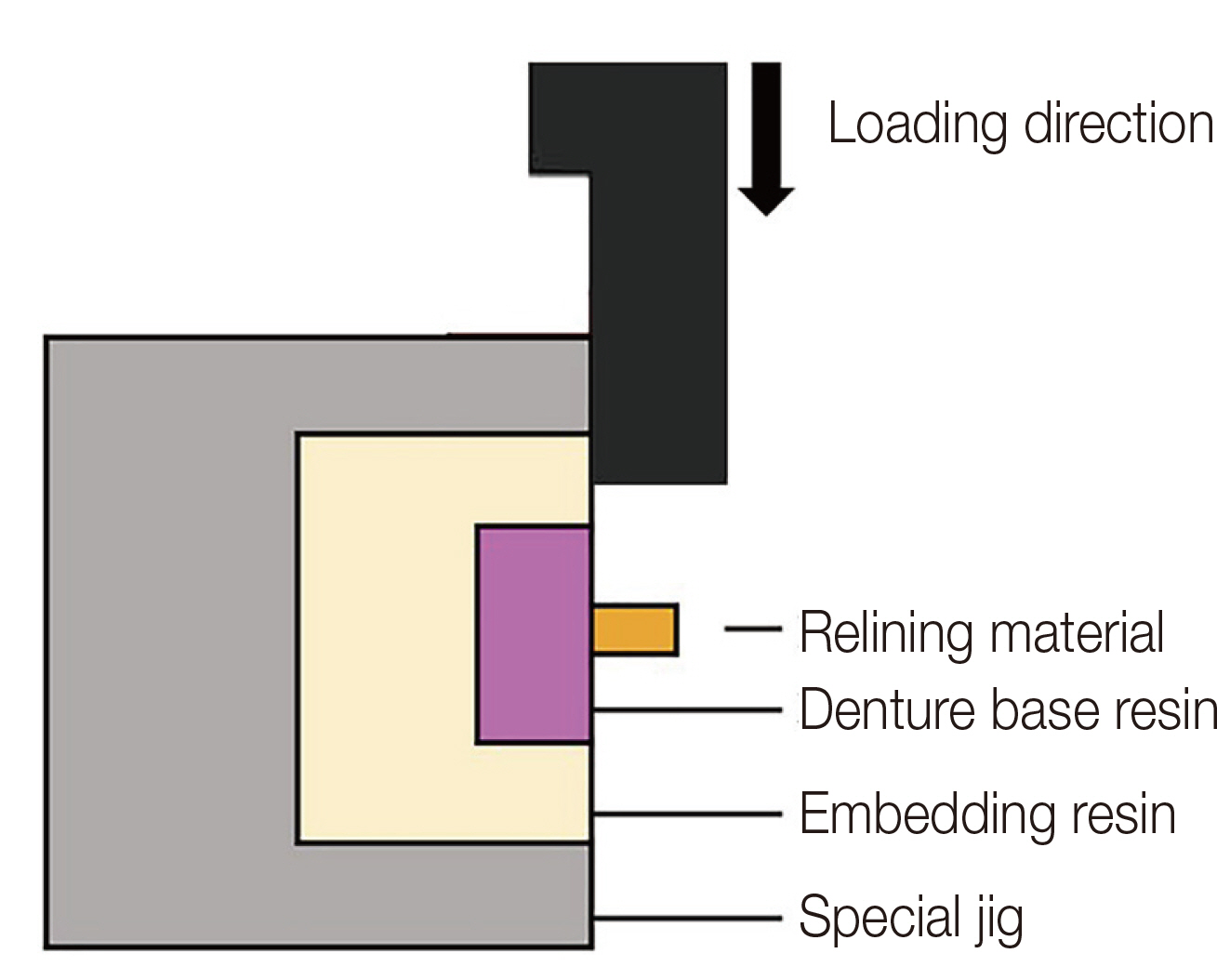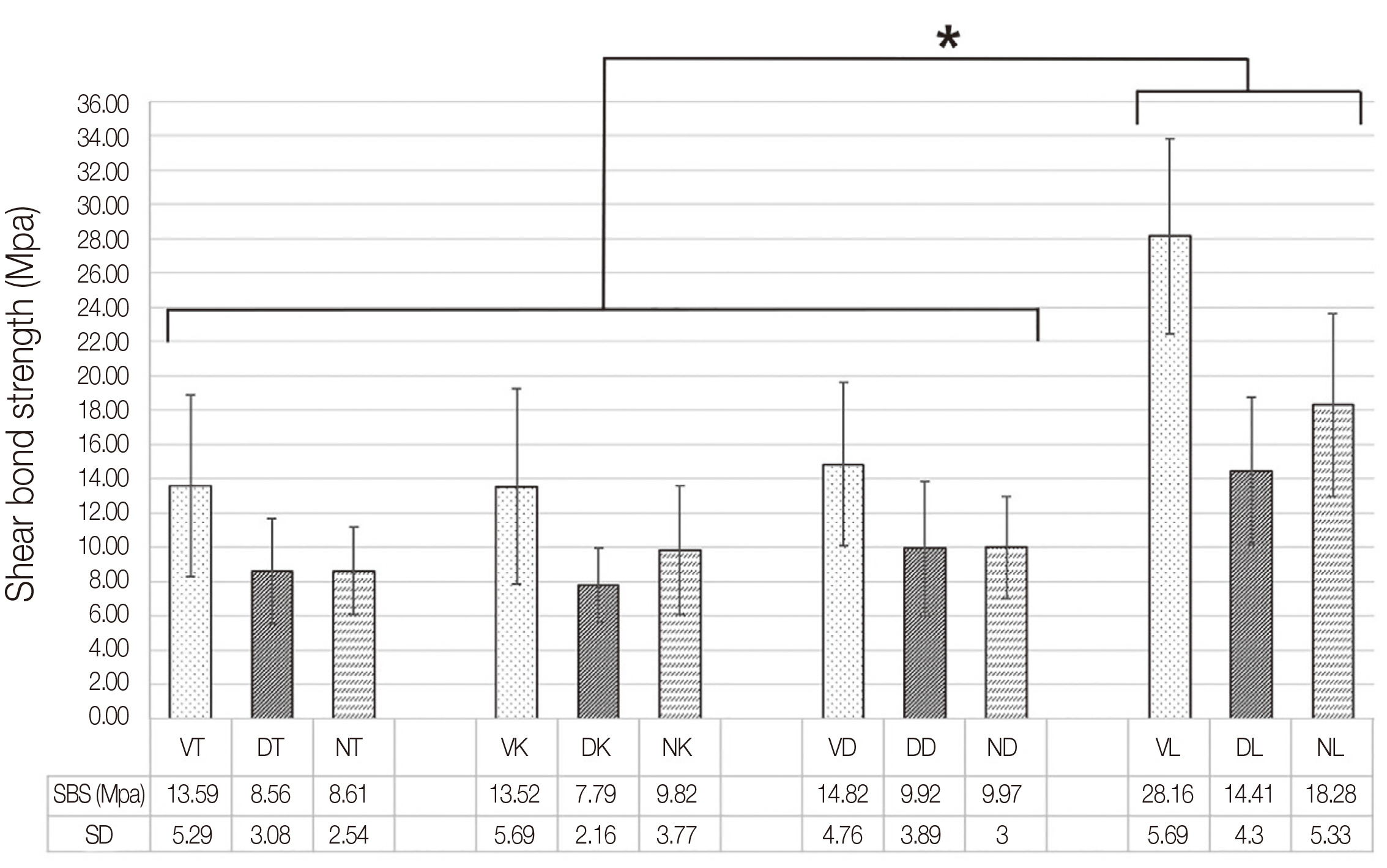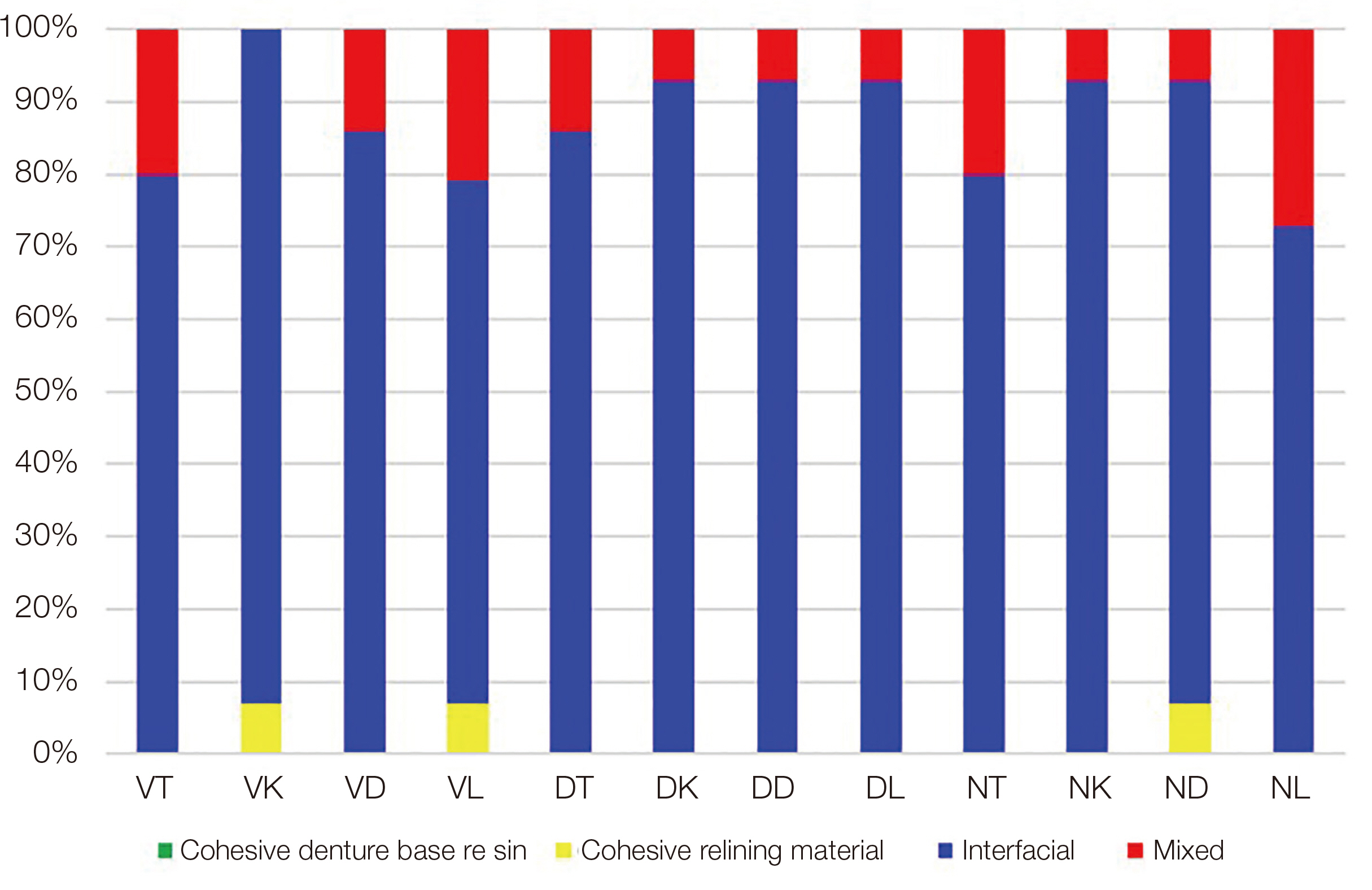J Dent Rehabil Appl Sci.
2021 Dec;37(4):232-243. 10.14368/jdras.2021.37.4.232.
A comparison study on shear bond strength of 3D printed resin and conventional heat-cured denture base resin to denture relining materials
- Affiliations
-
- 1Department of Prosthodontics, College of Dentistry, Dankook University, Cheonan, Republic of Korea
- KMID: 2525998
- DOI: http://doi.org/10.14368/jdras.2021.37.4.232
Abstract
- Purpose
The purpose of this study was to evaluate the shear bond strength of various 3D printed denture base resins and the conventional denture base resin to various denture relining materials.
Materials and Methods
For denture base materials, a heatcured (Vertex RS) and two types of 3D printed DENTCA Denture base II, NextDent TM Base) were used. And 4 types denture relining materials (Tokuyama Rebase II fast, Kooliner, Denture Liner, Denture Liner, Lang Jet Denture Repair Kit) with different components were used. It was classified into 12 groups. Adhesion was performed between the resin base and the relining materials in accordance with ISO/TS 11405 standard. The shear bonding strength was measured, and then the adhesion interface was observed with a stereoscopic microscope and a scanning electron microscope. The fracture pattern was investigated through the analysis of the fragment.
Results
In the 3D printed denture resin group, the shear bonding strength with relining materials was significantly lower than that of the heat-cured resin group (P < 0.05). The group of polymethyl methacrylate -based relining materials, high shear bonding strength was shown regardless of the type of denture. As for the fracture pattern, adhesive fracture appeared in most groups, and cohesive, mixed fracture appeared in some groups.
Conclusion
The polymethyl methacrylate -based denture relining materials showed high shear bonding strength values compared to other denture relining materials. But, for direct methods, it is considered advantageous in terms of shear bonding strength to use a isobutyl methacrylate-based denture relining materials.
Figure
Cited by 2 articles
-
Comparison of shear bond strength between hard relining material and 3D-printing denture base resin containing silica micro-gel
Yeon-Woo Lee, Young-Gyun Song
J Dent Rehabil Appl Sci. 2023;39(2):79-88. doi: 10.14368/jdras.2023.39.2.79.Clinical considerations for complete denture relining
Young-Eun Cho
J Dent Rehabil Appl Sci. 2024;40(2):39-45. doi: 10.14368/jdras.2024.40.2.39.
Reference
-
References
1. Zarb GA, Bolender CL. 2004. Prosthodontic treatment for edentulous patients. 12th ed. Mosby;St. Louis: p. 190–207.2. Baba NZ. 2016; Materials and processes for CAD/CAM complete denture fabrication. Curr Oral Health Rep. 3:203–8. DOI: 10.1007/s40496-016-0101-3.3. Bidra AS, Tylor TD, Agar JR. 2013; Computer-aided technology for fabricating complete dentures: systematic review of historical background, current status, and future perspectives. J Prosthet Dent. 109:361–6. DOI: 10.1016/S0022-3913(13)60318-2. PMID: 23763779.4. Fasbinder DJ. 2006; Clinical performance of chairside CAD/CAM restorations. J Am Dent Assoc. 137:22S–31S. DOI: 10.14219/jada.archive.2006.0395. PMID: 16950934.5. Kawahata N, Ono H, Nishi Y, Hamano T, Nagaoka E. 1997; Trial of duplication procedure for complete dentures by CAD/CAM. J Oral Rehabil. 24:540–8. DOI: 10.1046/j.1365-2842.1997.00522.x. PMID: 9250843.6. Inokoshi M, Kanazawa M, Minakuchi S. 2012; Evaluation of a complete denture trial method applying rapid prototyping. Dent Mater J. 31:40–6. DOI: 10.4012/dmj.2011-113. PMID: 22277604.7. Steinmassl PA, Klaunzer F, Steinmassl O, Dumfahrt H, Grunert I. 2017; Evaluation of currently available CAD/CAM denture systems. Int J Prosthodont. 30:116–22. DOI: 10.11607/ijp.5031. PMID: 28267817.8. Goodacre CJ, Garbacea A, Naylor WP, Daher T, Marchack CB, Lowry J. 2012; CAD/CAM fabricated complete dentures: concepts and clinical methods of obtaining required morphological data. J Prosthet Dent. 107:34–46. DOI: 10.1016/S0022-3913(12)60015-8. PMID: 22230914.9. Kattadiyil MT, Goodacre CJ, Baba NZ. 2013; CAD/CAM complete dentures: a review of two commercial fabrication systems. J Calif Dent Assoc. 41:407–16. PMID: 23875432.10. Goodacre BJ, Goodacre CJ, Baba NZ, Kattadiyil MT. 2016; Comparison of denture base adaptation between CAD-CAM and conventional fabrication techniques. J Prosthet Dent. 116:249–56. DOI: 10.1016/j.prosdent.2016.02.017. PMID: 27112416.11. Ohkubo C, Park EJ, Kim TH, Kurtz KS. 2018; Digital Relief of the Mental Foramen for a CAD/CAMFabricated Mandibular Denture. J Prosthodont. 27:189–92. DOI: 10.1111/jopr.12476. PMID: 26999626.12. Infante L, Yilmaz B, McGlumphy E. 2014; Fabricating complete dentures with CAD/CAM technology. J Prosthet Dent. 111:351–5. DOI: 10.1016/j.prosdent.2013.10.014. PMID: 24461946.13. Goodacre BJ, Goodacre CJ, Baba NZ, Kattadiyil MT. 2016; Comparison of denture base adaptation between CAD-CAM and conventional fabrication techniques. J Prosthet Dent. 116:249–56. DOI: 10.1016/j.prosdent.2016.02.017. PMID: 27112416.14. McLaughlin JB, Ramos V Jr. 2015; Complete denture fabrication with CAD/CAM record bases. J Prosthet Dent. 114:493–7. DOI: 10.1016/j.prosdent.2015.04.017. PMID: 26139040.15. Maeda Y, Minoura M, Tsutsumi S, Okada M, Nokubi T. 1994; A CAD/CAM system for removable denture. Part I: Fabrication of complete dentures. Int J Prosthodont. 7:17–21. PMID: 8179777.16. Kattadiyil MT, AlHelal A. 2017; An update on computerengineered complete dentures: A systematic review on clinical outcomes. J Prosthet Dent. 117:478–85. DOI: 10.1016/j.prosdent.2016.08.017. PMID: 27881317.17. Dorner S, Zeman F, Koller M, Lang R, Handel G, Behr M. 2010; Clinical performance of complete dentures: a retrospective study. Int J Prosthodont. 23:410–7. PMID: 20859555.18. Felton D, Cooper L, Duqum I, Minsley G, Guckes A, Haug S, Meredith P, Solie C, Avery D, Chandler ND. American College of Prosthodontists. 2011; Evidence-based guidelines for the care and maintenance of complete dentures: a publication of the American College of Prosthodontists. J Prosthodont. 20:S1–12. DOI: 10.1111/j.1532-849X.2010.00683.x. PMID: 21324026.19. Bergman B, Carlsson GE. 1985; Clinical long-term study of complete denture wearers. J Prosthet Dent. 53:56–61. DOI: 10.1016/0022-3913(85)90066-6. PMID: 3882949.20. Fish EW. 1931; An analysis of the stabilizing factors in full denture construction. Br Dent J. 52:559–70.21. Jung CM. 2001. Atlas of Chairside Relining Technique. Shinhung Int Inc.;Seoul: p. 13–32.22. Chung CH. 1994. Complete denture prosthodontics. Jisung;Seoul: p. 496–9.23. Ogle RE, Sorensen SE, Lewis EA. 1986; A new visible light-cured resin system applied to removable prosthodontics. J Prosthet Dent. 56:497–506. DOI: 10.1016/0022-3913(86)90397-5. PMID: 3463760.24. Kim KS, Jeong HY, Kim YL, Cho HW. 2003; The effect of denture cleansers on the bond strength and the surface hardness of reline resin to denture base resin. J Korean Acad Prosthodont. 41:493–502.25. Takahashi Y, Chai J. 2001; Assessment of shear bond strength between three denture reline materials and a denture base acrylic resin. Int J Prosthodont. 14:531–5. PMID: 12066699.26. Egilmez F, Ergun G, Cekic-Nagas I, Vallittu PK, Lassila LV. 2018; Does artificial aging affect mechanical properties of CAD/CAM composite materials. J Prosthodont Res. 62:65–74. DOI: 10.1016/j.jpor.2017.06.001. PMID: 28647224.27. AlHelal A, AlRumaih HS, Kattadiyil MT, Baba NZ, Goodacre CJ. 2017; Comparison of retention between maxillary milled and conventional denture bases: a clinical study. J Prosthet Dent. 117:233–8. DOI: 10.1016/j.prosdent.2016.08.007. PMID: 27765399.28. Ortman HR, Ortman LF. 1975; Denture refitting with today's concepts and materials. Dent Clin North Am. 19:269–90.29. Patil SB, Naveen BH, Patil NP. 2006; Bonding acrylic teeth to acrylic resin denture bases: a review. Gerodontology. 23:131–9. DOI: 10.1111/j.1741-2358.2006.00129.x. PMID: 16919093.30. Craig RC. Restorative dental materials. 8th ed. CV Mosby;St Louis: p. 509–44.31. Phillips RW. Science of dental materials. 8th ed. WB Saunders;Philadelphia: p. 195–206.32. Lee S. 2016; Prospect for 3D printing technology in medical, dental, and pediatric dental field. J Korean Acad Pediatr Dent. 43:93–108. DOI: 10.5933/JKAPD.2016.43.1.93.33. Arima T, Murata H, Hamada T. 1996; Analysis of composition and structure of hard autopolymerizing reline resins. J Oral Rehabil. 23:346–52. DOI: 10.1111/j.1365-2842.1996.tb00863.x. PMID: 8736448.34. Vallittu PK, Ruyter IE. 1997; Swelling of poly(methyl methacrylate) resin at the repair joint. Int J Prosthodont. 10:254–8. PMID: 9484058.35. Park C, Kim MH, Go JS, Hong SM, Shin BS. 2015; A study on the comparison mechanical properties of 3D printing prototypes with laminating direction. J Korean Soc Manuf Technol Eng. 24:334–41. DOI: 10.7735/ksmte.2015.24.3.334.36. Strohaver RA. 1989; Comparison of changes in vertical dimension between compression and injection molded complete dentures. J Prosthet Dent. 62:716–8. DOI: 10.1016/0022-3913(89)90599-4. PMID: 2685262.37. Mutluay MM, Ruyter IE. 2005; Evaluation of adhesion of chairside hard relining materials to denture base polymers. J Prosthet Dent. 94:445–52. DOI: 10.1016/j.prosdent.2005.08.011. PMID: 16275305.38. Takahashi Y, Chai J. 2001; Shear bond strength of denture reline polymers to denture base polymers. Int J Prosthodont. 14:271–5. PMID: 11484577.39. Arima T, Murata H, Hamada T. 1995; Properties of highly cross-linked autopolymerizing reline resins. J Prosthet Dent. 73:55–9. DOI: 10.1016/S0022-3913(05)80273-2.40. Arima T, Murata H, Hamada T. 1996; Analysis of composition and structure of hard autopolymerizing reline resins. J Oral Rehabil. 23:346–52. DOI: 10.1111/j.1365-2842.1996.tb00863.x. PMID: 8736448.41. Li GZ, Cho H, Wang L, Toghiani H, Pittman CU Jr. 2005; Synthesis and properties of poly(isobutyl methacrylate-co-butanediol dimethacrylate-co-methacryl polyhedral oligomeric silsesquioxane) nanocomposites. J Polym Sci A Polym Chem. 43:355–72. DOI: 10.1002/pola.20503.42. Sarac YS, Sarac D, Kulunk T, Kulunk S. 2005; The effect of chemical surface treatments of different denture base resins on the shear bond strength of denture repair. J Prosthet Dent. 94:259–66. DOI: 10.1016/j.prosdent.2005.05.024. PMID: 16126078.43. Digholkar S, Madhav VN, Palaskar J. 2016; Evaluation of the flexural strength and microhardness of provisional crown and bridge materials fabricated by different methods. J Indian Prosthodont Soc. 16:328–34. DOI: 10.4103/0972-4052.191288. PMID: 27746595. PMCID: PMC5062140.44. Alharbi N, Osman R, Wismeijer D. 2016; Effects of build direction on the mechanical properties of printed complete coverage interim dental restorations. J Prosthet Dent. 115:760–7. DOI: 10.1016/j.prosdent.2015.12.002. PMID: 26803175.
- Full Text Links
- Actions
-
Cited
- CITED
-
- Close
- Share
- Similar articles
-
- Comparison of shear bond strength between hard relining material and 3D-printing denture base resin containing silica micro-gel
- The Effects Of Thermocycling On The Bond Strength Between Cobalt-Chromium Alloy And Denture Base Resin
- Nonthermal plasma on the shear bond strength of relining resin to thermoplastic denture base resin
- Effect of surface design on bond strength of relining denture resin
- Shear bond strength between CAD/CAM denture base resin and denture artificial teeth when bonded with resin cement








